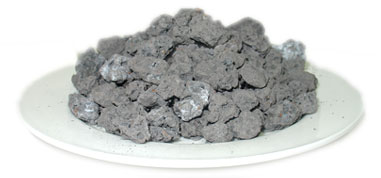Electric Arc Furnace Slag (EAFS)
Brief Description 
EAFS is a by-product of the steel-making process. EAFS solidifies in a similar manner to lava from a volcano. Its cooled structure is best described as a solid solution of oxides.
Physical Description
EAFS is produced in an Electric Arc Furnace. The slag is dark grey in colour and is characteristically harder than blast furnace slag (BFS). It has a density about 20 - 25% greater than basalt or BFS. It crushes to a cubical shape.
EAFS in common with most steel slags, is subject to slight dimensional expansion until it fully hydrates. Until this occurs, care should be taken not to place it in rigidly confined spaces.
Method of Manufacture
Steel and molten slag are produced during the melting and refining of recycled steel using electrical energy and fluxes. Lime is used as a flux to remove silicates and phosphorus from the molten steel to form slag. Energy is supplied by an electric arc, melting the steel and fluxes. During the refining or superheating stage (of the slag process), slag is tapped or poured out of the slag door. On tapping, steel is drained from the furnace via a submerged taphole and the furnace is back tilted to prevent slag entering the steel ladle.
Directed into pits adjacent to the process, molten slag (and residual molten steel) flows out the slag door of the furnace. The molten slag then begins to solidify fairly quickly into a rock-like product.
Since the molten slag is accompanied by residual solidified steel (metallics), the solidified material is excavated by a front-end loader from the bays when cooled, and transported by road to a metallic separation, crushing and screening plant. Metallics are removed and recycled as ferrous feed or scrap to the iron and steel making processes of the steelworks.
Diagram of Manufacture
Applications
Similar to Steel Furnace Slag (SFS), EAFS have similar self-cementing characteristics for heavy duty pavement applications. Unconfined compressive strength (UCS) > 5 MPa has been achieved at 28 days damp. As a tough durable material, EAFS has excellent skid resistance properties compared to basalt, making it an ideal aggregate for this application. Resistance to rutting makes EAFS particularly applicable for heavily trafficked corners and stopping zones.
Typical uses for EAFS are:
- Sealing aggregate (skid resistant)
- Asphalt Aggregate
- Base, Subbase
- Construction fills
- Subsoil drains
- Grit blasting.


